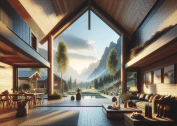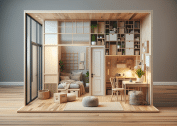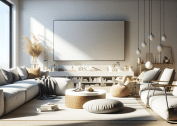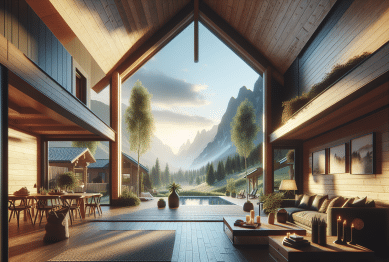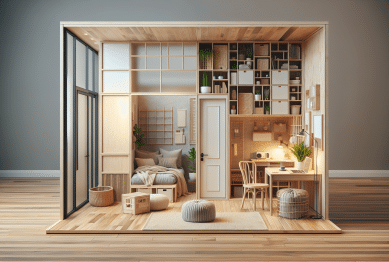Unlock the secrets to refreshing your home and elevating daily living through smart interior design. This guide explores practical methods, current decor trends, and room-by-room tips to create spaces that feel inspiring, functional, and true to your style. Discover easy approaches anyone can use to enhance comfort and atmosphere.
The Power of Color in Home Makeovers
Color is a powerful tool for interior design—it sets the mood, defines spaces, and even affects how large or small a room feels. Explore how the right paint choices, from neutral backdrops to bold accent walls, can energize or relax any living area. Light hues can make rooms look bright and open, while darker shades add cozy sophistication. Incorporating current color psychology concepts adds real energy to your space and can help guide both large and small updates. Color also connects themes from one room to another, making the entire home feel harmonious.https://www.architecture.com/knowledge-and-resources/knowledge-landing-page/how-colour-affects-architecture
Choosing a color palette isn’t just about style—it’s about personality and purpose. Soft greens or calming blues may be perfect for bedrooms where relaxation is key. Vivid yellows or oranges in kitchens or creative spaces inspire energy and creativity. Pay attention to how natural lighting changes throughout the day, as it can transform the perception of your chosen hues. Testing samples in different areas ensures you achieve the ambience you want. Sometimes, small details like colored trims or painted furniture offer enough visual change to refresh an entire room without a major renovation.
Coordinate color with existing furniture or statement pieces to build a cohesive look. Artwork, textiles, and rugs all present opportunities to reinforce or introduce color themes. For renters or those looking for non-permanent changes, peel-and-stick wallpaper or removable decals let anyone switch things up with ease. These design tricks enable exploration, refinement, and personalization at any stage of your home journey. Ultimately, intentional color use shapes not only visual appeal but also daily experience and comfort.https://www.houzz.com/magazine/how-to-choose-a-color-palette-for-your-whole-home-stsetivw-vs~53061383
Maximizing Natural Light and Space
The use of natural light is central to creating interiors that feel open and inviting. Large windows, well-placed mirrors, and strategic furniture arrangements help maximize sunlight, brightening even compact rooms. Consider using sheer window coverings or minimalist blinds to allow for unobstructed daylight flow. Well-lit rooms aren’t just cheerful—they tend to look and feel spacious, too. If architectural limitations exist, daylight-simulating LEDs or smart lighting systems support a similar uplifting atmosphere without structural changes.https://www.energy.gov/energysaver/energy-efficient-lighting
Smart design emphasizes how furniture is placed and chosen. Multifunctional pieces—like storage ottomans or nesting tables—help reduce clutter while keeping style in focus. Wall-mounted shelves take advantage of vertical space, leaving floors open for movement. Large mirrors reflect more than just a good outfit—they amplify light, create the illusion of depth, and reflect outdoor views inward. Thoughtful reconfiguration, such as floating furniture away from walls or removing unused items, instantly transforms how livable and organized spaces feel.
Clear walkways and intentional traffic flow are essential for both visual and practical comfort. Keep paths between major pieces wide enough for easy movement. Use rugs and lighting to define functional zones within open-plan areas. For smaller apartments or shared living spaces, folding screens or low bookshelves can distinguish private nooks without blocking light. Blending efficiency and beauty supports not only daily routines but the overall energy of your home.https://www.habitat.org/stories/affordable-ways-make-your-home-more-energy-efficient
Personalizing Decor with Statement Pieces
Personal touches turn any space into a true reflection of individual taste and life story. Statement pieces—be it an eye-catching armchair, an heirloom painting, or a handwoven textile—anchor the narrative of a room. Decorating with these meaningful objects can foster positive emotions and spark conversation. Choose one or two focal pieces per area and arrange supporting items to let these treasures shine, whether on a gallery wall or a shelf.
Mixing new and vintage decor creates a dynamic environment. Shop local markets, online platforms, or even family attics for items that evoke emotion or memory. Consider rotating art, textiles, or ceramics seasonally to keep spaces feeling fresh and surprising. Balance bold features with subtler background decor so that nothing feels overwhelming. Layering textures—such as metals, woods, or woven goods—adds dimension and tactile interest to every room. The goal is a curated, inviting space that feels welcoming upon every return.
Don’t overlook small creative projects. Custom pillow covers, painted plant pots, or do-it-yourself wall art can be accessible, budget-friendly introductions to personalization. Try rearranging treasured objects seasonally or as your tastes evolve. Allow your living area to evolve just as you do—it’s a space where personality is at home alongside practicality.https://www.archdaily.com/935593/10-tips-to-make-small-interiors-feel-larger
Embracing Sustainable and Smart Interior Design
Today’s leading interior design trends place a strong emphasis on sustainability and smart technology. Eco-friendly design can include using reclaimed wood, recycled material furnishings, or paints free of volatile organic compounds. These choices support both planetary health and indoor air quality. Simple switches, like opting for LED lights or water-efficient fixtures, add to energy conservation while often reducing long-term utility costs. Certain home automation gadgets—programmable thermostats, smart plugs, or lighting controls—contribute to efficient routines without sacrificing style.https://www.epa.gov/greenhomes
Sustainable living isn’t just about products—it’s also about habits. Reconfiguring rooms for passive climate control, such as placing curtains to block midday sun or using fans for cross-ventilation, demonstrates how design thinking meets environmental stewardship. Thrift shopping or upcycling older furniture keeps items out of landfills and allows for creative updates tailored exactly to personal taste. Sustainability doesn’t mean giving up comfort; it means finding beautiful new ways to blend purpose and pleasure for long-lasting results.
Tech-driven interiors add a layer of ease to everyday life. Voice-activated lighting, smart appliances, or integrated home management platforms streamline chores and support security. Many of these upgrades are increasingly accessible and even compatible with existing decor. The intersection of sustainability and smart living enables anyone to create interiors that are adaptable for future demands and shifting lifestyle needs.https://www.energy.gov/eere/buildings/articles/green-your-home-tips-sustainable-living
Room-by-Room Styling Ideas for Comfort and Function
Approaching design one room at a time helps focus on both broad vision and practical solutions. In the living room, layering throw blankets and cushions encourages relaxation, while a combination of task and ambient lighting supports gatherings as well as solo downtime. Bedrooms benefit from blackout curtains, plush textiles, and calming color schemes for restful sleep. Entryways need clever storage—benches with compartments or wall hooks—so essentials are always within reach, reducing clutter and stress at home transitions.
Kitchens are both a work zone and a hub for gathering—open shelving, multipurpose islands, and easy-clean surfaces streamline cooking and cleanup. Consider hanging pendant lights above eating areas or incorporating a bold tile backsplash for a dash of personality. Bathrooms feel like retreats when filled with spa-inspired accessories: fluffy towels, soothing candles, and well-placed greenery. Attractive storage organizers and baskets make even small spaces function beautifully.
Don’t underestimate outdoor and transitional spaces. A small balcony, patio, or window seat becomes an inviting extension of living quarters with simple additions—outdoor rugs, planters, or all-weather cushions. Integrate privacy screens or potted plants for intimacy and style. Room-by-room planning ensures every inch of your home reaches its full potential and grows with you over time.https://www.nahb.org/other/consumer-resources/homeownership/room-by-room-upgrading-your-home
Staying Inspired with Trends and Design Communities
Following trends isn’t about complete transformations—it’s about inspiration and bringing fresh life to familiar rooms. Online platforms, magazines, and social media abound with creative ideas for every taste, from minimalism to maximalism. Digital mood boards let you play with combinations risk-free before making final decisions. Trends like biophilic design, which emphasizes a connection with nature, and open concept layouts often inform the latest in interior design thinking. Even a few subtle updates sometimes offer all the change that’s needed.
Design communities—both online and in-person—help individuals learn, share challenges, and celebrate successes. Engaging with these spaces encourages experimentation and problem solving. Many offer virtual workshops, renovation diaries, or peer advice to support action at any budget or scale. No one’s journey to a refreshed home is identical, and that’s what makes the process creative and rewarding. Inspiration flows from seeing what others do and adapting concepts to your own needs.
Stay engaged by seeking out local open houses, showrooms, or virtual 3D home tours. Museums or historic sites can also reveal timeless patterns and materials that work in any context. By combining research, observation, and small tests, you develop a unique style and flexible design intuition. Keeping a curiosity mindset lets home transformation remain enjoyable, accessible, and ever-evolving.https://www.interiordesign.net/projects/18305-ways-to-find-inspiration-for-your-next-design-project/
References
1. Royal Institute of British Architects. (n.d.). How colour affects architecture. Retrieved from https://www.architecture.com/knowledge-and-resources/knowledge-landing-page/how-colour-affects-architecture
2. Houzz. (n.d.). How to choose a color palette for your whole home. Retrieved from https://www.houzz.com/magazine/how-to-choose-a-color-palette-for-your-whole-home-stsetivw-vs~53061383
3. U.S. Department of Energy. (n.d.). Energy efficient lighting. Retrieved from https://www.energy.gov/energysaver/energy-efficient-lighting
4. Habitat for Humanity. (n.d.). Affordable ways to make your home more energy efficient. Retrieved from https://www.habitat.org/stories/affordable-ways-make-your-home-more-energy-efficient
5. U.S. Environmental Protection Agency. (n.d.). Green homes. Retrieved from https://www.epa.gov/greenhomes
6. National Association of Home Builders. (n.d.). Room-by-room: upgrading your home. Retrieved from https://www.nahb.org/other/consumer-resources/homeownership/room-by-room-upgrading-your-home



